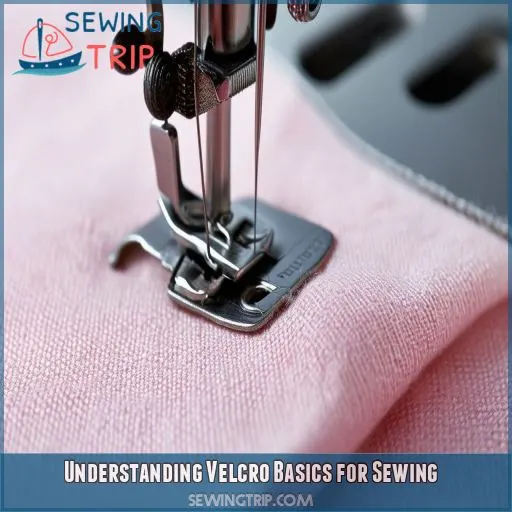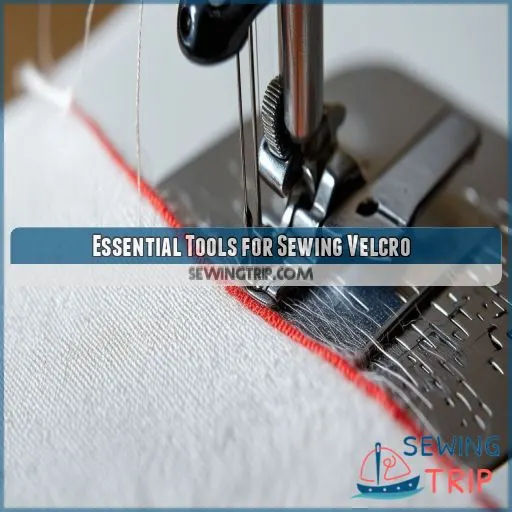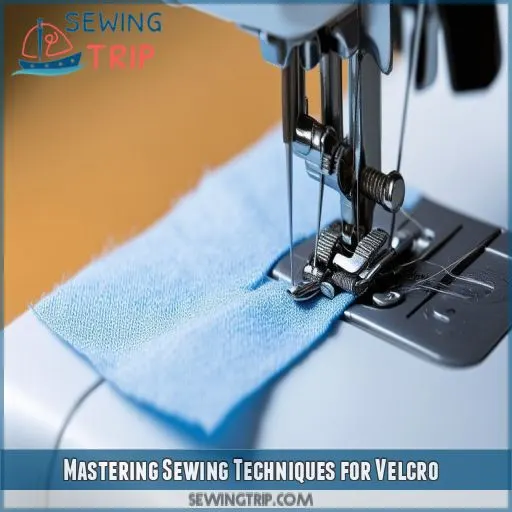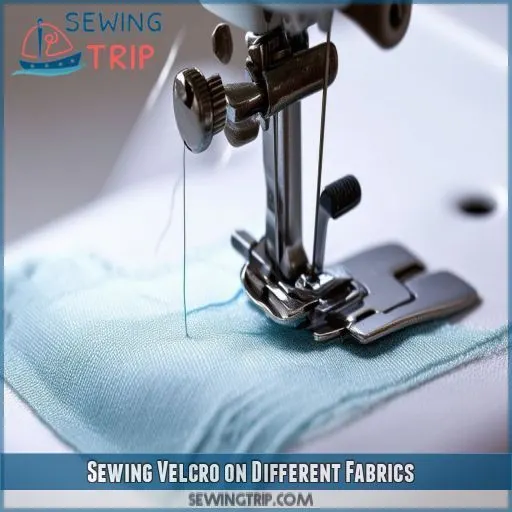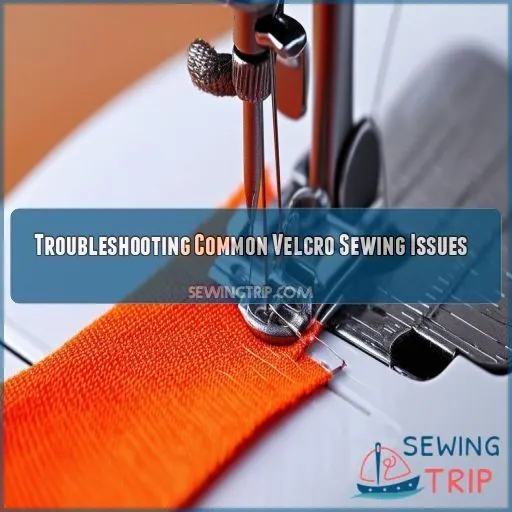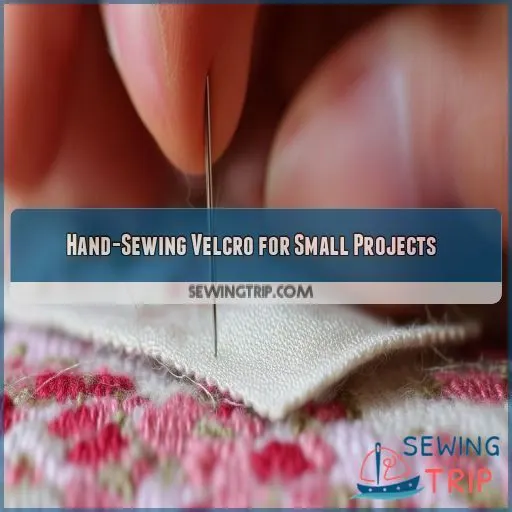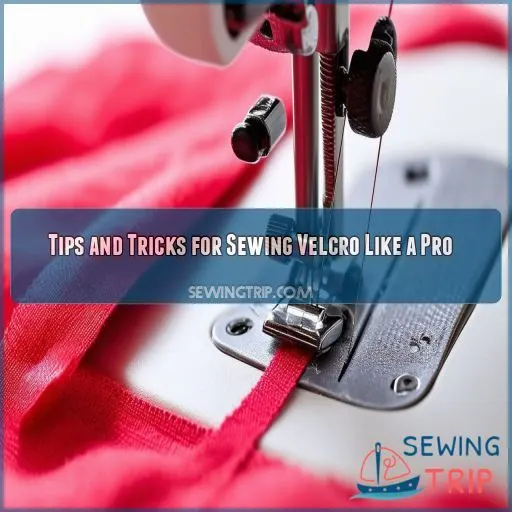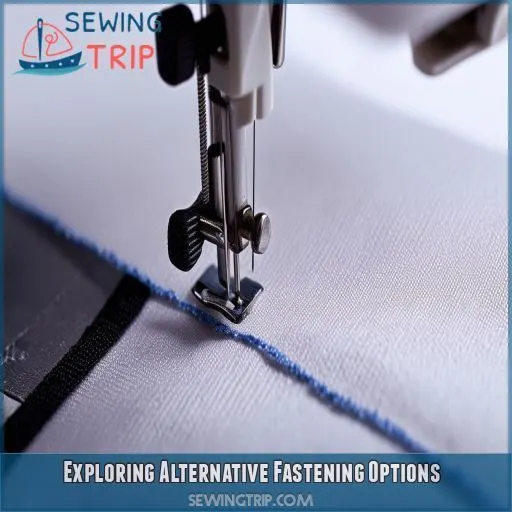This site is supported by our readers. We may earn a commission, at no cost to you, if you purchase through links.
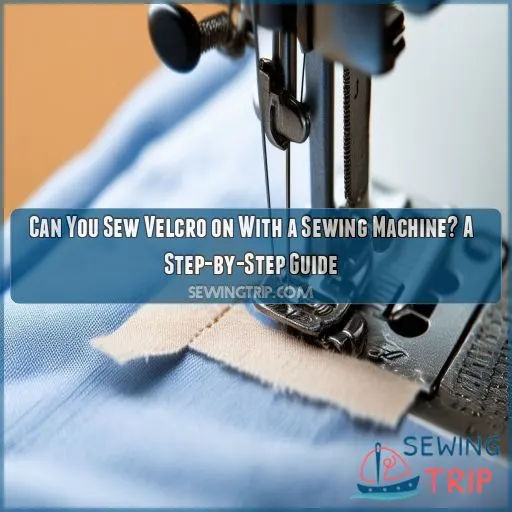
This step-by-step guide will show you how to tackle this task like a pro.
Whether you’re fixing a jacket or creating a custom project, we’ll walk you through choosing the right tools, mastering the technique, and troubleshooting common issues.
Get ready to become a confident seamstress and conquer Velcro with ease!
Table Of Contents
- Key Takeaways
- Can You Sew Velcro on With a Sewing Machine?
- Understanding Velcro Basics for Sewing
- Essential Tools for Sewing Velcro
- Mastering Sewing Techniques for Velcro
- Sewing Velcro on Different Fabrics
- Troubleshooting Common Velcro Sewing Issues
- Hand-Sewing Velcro for Small Projects
- Tips and Tricks for Sewing Velcro Like a Pro
- Exploring Alternative Fastening Options
- Frequently Asked Questions (FAQs)
- Conclusion
Key Takeaways
- You betcha! Sewing Velcro with a machine is like riding a bike – once you get the hang of it, you’ll be zooming through projects in no time.
- Choosing the right tools is half the battle. A sturdy needle and strong thread are your dynamic duo for tackling Velcro like a superhero.
- Alignment is key – nobody wants wonky Velcro! Take a moment to line things up, and your future self will thank you for the crisp, professional look.
- Don’t sweat the small stuff. If you hit a snag, remember that even seasoned pros have their Velcro moments. Take a deep breath, maybe grab a snack, and try again.
Can You Sew Velcro on With a Sewing Machine?
So, can you sew Velcro on with a sewing machine? The short answer is yes, you absolutely can. But there’s a bit more to it than that, so read on to find out everything you need to know about sewing Velcro with a sewing machine.
Choosing the Right Velcro for Sewing
When choosing Velcro for sewing, it’s important to select the right type for your project. Here are some key considerations:
- Quality: Opt for high-quality Velcro that’s soft and designed for sewing.
- Types: Sew-on Velcro is perfect for sewing projects, while iron-on Velcro is better for heavier fabrics.
- Fabric compatibility: Consider the fabric you’re using. Heavier fabrics like denim may call for stronger Velcro.
Selecting the Correct Thread and Needle
Choosing the right thread and needle for sewing Velcro is important. First, pick a strong polyester thread – matching the color to your Velcro for a seamless look. If you’re working with tougher fabrics, consider reinforced thread options like Rasant.
For the needle, go with a sharp, thicker universal needle in size 14 or 16. If you encounter any issues with needles breaking or bending, switch to a denim or leather needle for added strength.
Preparing Fabric for Velcro Attachment
Getting your fabric ready is key to making sure your Velcro sticks on tight and looks good. Here’s what you need to do:
- Clean the fabric surface: Get rid of any dirt, dust, or oils so the Velcro will stick strong.
- Trim loose threads: Cut off any loose threads at the edges of the fabric to keep it from fraying.
- Measure and mark: Figure out where you want the Velcro strips to go, and use a marker or chalk to mark the fabric.
- Cut Velcro strips: Cut the strips to the size you need, making sure you have both the hook and loop sides.
Understanding Velcro Basics for Sewing
Velcro is a handy hook-and-loop fastener that’s a breeze to use and sew. Before you start stitching, it’s good to get to grips with the basics so you can avoid any snags and sew with confidence.
Hook and Loop Sides of Velcro
Velcro has two distinct personalities—I mean, sides. One side is all smooth and soft, like a cute little bunny, while the other side is a bit scratchy, with tiny loops that give it some attitude. Think of it like the yin and yang of the fastening world.
| Hook Side | Loop Side |
|---|---|
| Tiny hooks that latch on | Soft loops that get captured |
| Scratchy texture | Smooth feel |
| Usually faces out | Typically faces in |
When you’re getting ready to sew, make sure you’ve got the right sides lined up. You don’t want to end up with a case of mistaken identity, or worse, a Velcro identity crisis!
Velcro as a Substitute for Buttons or Zippers
Velcro is a versatile fastener that can be used in place of buttons or zippers. It’s a great alternative for a few reasons:
- You can say goodbye to tedious buttonholes or tricky zippers.
- It’s easy to fasten and unfasten, making it convenient for those busy mornings.
- Velcro provides a secure connection without the hassle of traditional closures.
Benefits of Using Velcro in Sewing
Velcro is a versatile fastener that’s easy to use and durable. It’s a hook-and-loop fastener, offering a secure connection that’s also temporary. You can easily fasten and unfasten it without the fuss of buttons or zippers. It’s an adaptable, inexpensive option for many projects.
Essential Tools for Sewing Velcro
You’re keen to get started sewing Velcro, but hold your horses. First, you need to gather the right tools to make the process a breeze. From needles to thread, let’s check out the essential toolkit for sewing Velcro like a pro.
Needles for Sewing Velcro
Needles are a big deal, so here’s the lowdown:
- Go for a sharp, thicker needle like a universal needle in size 14 or 16.
- If you’re having trouble with needles breaking or bending, try a denim or leather needle.
- The needle you choose depends on the fabric. For example, use a ballpoint needle for fleece and a heavy-duty needle for canvas.
- For hand-sewing, pick a needle size that works with the thickness of your fabric.
Thread Options for Velcro Attachment
When picking a thread for attaching Velcro, you’ve got a few choices. Go for a strong polyester thread that matches the color of your Velcro. This gives you durability and a neat finish. If you’re dealing with tougher fabrics, consider a reinforced thread like Rasant. You want a thread that can handle the stress of holding Velcro in place.
Measuring and Cutting Velcro Strips
Measuring and cutting Velcro strips is all about getting the right size for your project.
You don’t want strips that are too short or too long—they need to fit just right.
So, take the time to measure twice and cut once.
It’s a simple step, but it’s key to getting it right so your Velcro sews on smoothly and securely.
Mastering Sewing Techniques for Velcro
Now that you’ve gathered the right tools and materials, it’s time to get started with the sewing techniques for Velcro. You’ll learn the ins and outs of stitching Velcro, from choosing the right stitch type to mastering placement for a polished look.
Straight Stitch Vs. Zigzag Stitch for Velcro
If you’re sewing on Velcro, the type of stitch you choose matters. You’ve got options: a straight stitch or a zigzag stitch.
The straight stitch is a classic. It’s simple, clean, and straightforward. You go straight down the line, and your Velcro is secure.
But let’s talk about the zigzag stitch. It’s like the fun, adventurous cousin of the straight stitch. With its back-and-forth motion, it adds a little extra something to your sewing. It’s like saying, "Hey, I’m here to party!
Backstitching for Durability and Security
Ready to level up your Velcro game?
Let’s talk backstitching – your secret weapon for rock-solid attachments. It’s like giving your Velcro a superhero cape!
At the start and end of each seam, reverse those stitches for a few rounds. This locks everything in place, ensuring your Velcro won’t bail on you mid-wear.
Trust us, this little trick will have your Velcro sticking around longer than your New Year’s resolutions!
Using a Zipper Foot for Easy Sewing
Now that you’ve mastered backstitching, let’s tackle using a zipper foot for easy Velcro sewing. This nifty attachment is your secret weapon for getting up close and personal with those tricky edges. Here’s why you’ll love it:
- Precision: Sew right up to the Velcro’s edge without a hitch.
- Visibility: Clear view of your stitching line for perfect placement.
- Versatility: Works on both hook and loop sides like a charm.
Ready to zip through your Velcro projects?
Sewing Velcro on Different Fabrics
You might think sewing Velcro is the same on all fabrics, but each material has its own quirks. Whether you’re working with cotton, polyester, denim, fleece, or canvas, we’ll guide you through the best thread and needle choices to make your Velcro stick like glue.
Cotton, Polyester, and Denim Fabric Considerations
When sewing Velcro, your fabric choice matters big time!
Cotton’s your easy-peasy option, while polyester might give you a run for your money.
Denim? Now that’s a whole different ballgame!
Each fabric has its quirks, so you’ll need to adjust your approach.
Think of it like cooking – different ingredients need different techniques.
Heavy-Duty Thread and Needle Options
When you’re tackling tougher fabrics, don’t skimp on your tools.
Grab a heavy-duty thread like polyester or nylon – they’re the superheroes of the sewing world.
Pair it with a denim or leather needle, and you’ll be unstoppable.
It’s like choosing the perfect dance partner – when you’ve got the right match, everything just flows smoothly.
Fleece and Canvas Fabric Tips for Velcro
When tackling fleece and canvas, you’re in for a treat!
For fleece, grab a ballpoint needle to glide through those cozy fibers.
Canvas is tough as nails, so arm yourself with a denim needle and heavy-duty thread.
Whether you’re mending, altering, or customizing, Velcro‘s your best friend for both fabrics.
It’s like giving your project superpowers – functional, convenient, and oh-so-durable.
Ready to conquer these fabrics? Let’s roll!
Troubleshooting Common Velcro Sewing Issues
Even the most experienced sewers can run into issues when attaching Velcro with a sewing machine. Whether you’re struggling with thick Velcro or adhesive-backed strips, we’ll help you troubleshoot common problems and get your project back on track.
Why Your Sewing Machine Won’t Sew Through Velcro
So, you’re ready to sew Velcro, but your machine’s throwing a tantrum?
Don’t sweat it! Common culprits include dull needles, incorrect tension, or wrong stitch length.
It’s like trying to cut a steak with a butter knife – frustrating and ineffective.
Boost your sewing mojo by switching to a sharp, sturdy needle (size 14 or 16), adjusting tension, and using a longer stitch length.
You’ll be stitching Velcro like a pro in no time!
Dealing With Thick or Adhesive-Backed Velcro
Tackling thick or adhesive-backed Velcro? Don’t sweat it! You’ve got this.
For thick Velcro, try a denim needle and lower your machine’s speed. It’s like driving through a traffic jam – slow and steady wins the race.
With adhesive-backed Velcro, use a Teflon foot or place tissue paper between the Velcro and your machine’s foot. This trick works wonders, just like using non-stick spray when baking!
Fixing Common Mistakes in Velcro Sewing
Even seasoned sewers hit snags with Velcro. Don’t fret!
If your stitches are skipping, try a fresh needle or adjust your tension.
Misaligned Velcro? No worries! Carefully unpick and realign using chalk marks.
Thread tangling? Slow down and guide fabric smoothly.
Hand-Sewing Velcro for Small Projects
While sewing machines are great for most Velcro projects, sometimes hand-sewing is your best bet for small or delicate items. You’ll be surprised how easy it’s to attach Velcro by hand, and with a few simple tips, you’ll be stitching like a pro in no time.
Choosing the Right Thread and Needle for Hand-Sewing
When hand-sewing Velcro, your choice of thread and needle can make or break your project.
Opt for a sturdy polyester thread that’ll stand up to the Velcro’s grip.
As for needles, go for a sharp, medium-sized one that can pierce through both fabric and Velcro without breaking a sweat.
Using Backstitch for Secure Attachment
When hand-sewing Velcro, the backstitch is your secret weapon for rock-solid attachment.
It’s like giving your project a superhero cape of strength!
Start by threading your needle and knotting the end.
Then, sew backward, creating a loop, and push the needle through that loop.
Repeat this dance along the edge of your Velcro, and you’ll have a bond that’s tougher than a drill sergeant’s resolve!
Tips for Smooth and Easy Hand-Sewing
Ready to hand-sew Velcro like a pro?
Let’s get started!
First, choose a needle size that matches your fabric’s weight.
Thread it with a sturdy polyester or nylon thread, and you’re set.
Keep your tension just right – not too tight, not too loose.
It’s like threading a needle through butter when you’ve got the hang of it.
Tips and Tricks for Sewing Velcro Like a Pro
You’ve mastered the basics of sewing Velcro, but now it’s time to take your skills to the next level. These pro tips and tricks will help you avoid common pitfalls and achieve flawless results every time you work with this versatile fastener.
Using High-Quality Velcro for Easy Sewing
You’ve got to be smart about your Velcro if you want to sew like a pro.
Don’t skimp on quality – it’s the secret sauce!
High-grade Velcro is softer, more pliable, and a dream to work with.
It’ll make your sewing machine purr instead of groan.
Plus, it’s built to last, so your creations will stand the test of time.
Trust me, your future self will thank you for this investment!
Aligning Hook and Loop Sides Correctly
Ready to conquer the Velcro alignment challenge? Here’s your secret weapon to becoming a Velcro virtuoso:
- Mark your fabric with chalk or removable pen
- Use a ruler for precise measurements
- Pin the hook side face-up on the outside
- Align the loop side face-down on the inside
Avoiding Common Mistakes in Velcro Sewing
Ready to sew Velcro like a pro?
Don’t let common pitfalls trip you up! First, make sure your Velcro’s aligned perfectly – it’s the secret sauce for a polished look.
Keep your stitch tension in check; too tight and you’ll pucker, too loose and it’ll flop.
Always opt for quality Velcro – it’s a game-changer.
Exploring Alternative Fastening Options
While Velcro is a versatile fastener, it’s not always the best choice for every project. Let’s explore some alternative options that might suit your needs better, from iron-on Velcro for heavy fabrics to zippers, buttonholes, and even trendy Kam snaps.
Iron-on Velcro for Heavy Fabrics
If you’re tackling heavy fabrics and your sewing machine’s throwing a tantrum, iron-on Velcro might be your knight in shining armor.
It’s like magic – no needles required! Just whip out your trusty iron or heat press, and voila!
You’ll be sticking things together faster than you can say "sticky back Velcro.
Zippers, Buttonholes, and Other Closure Options
While sewing Velcro is the magic solution for many projects, sometimes you’ll want to explore other closure options. Zippers, buttonholes, and hooks can add a touch of sophistication to your creations. Here’s a quick rundown of alternatives:
- Zippers: Great for smooth, secure closures
- Buttonholes: Classic and versatile
- Hooks and eyes: Perfect for delicate fabrics
- Clasps: Ideal for bags and accessories
Kam Snaps and Press Studs for Easy Fastening
While sewing Velcro might seem like everything, there’s a whole world of fastening options out there!
Kam snaps and press studs are your new best friends for easy closures.
They’re a breeze to install and provide a satisfying ‘click’ that’ll make you feel like a fastening wizard.
No more wrestling with buttonholes or zippers – these alternatives will have you snapping your way to sewing freedom in no time!
Frequently Asked Questions (FAQs)
Can you sew through stick-on velcro?
You can sew through stick-on Velcro, but it’s not ideal. The adhesive might gum up your needle and machine. If you’re in a pinch, try a heavy-duty needle and go slow. Sew-on Velcro’s your best bet, though!
What thread do I use for stick on velcro?
Ironically, you’re asking about thread for stick-on Velcro! You don’t need thread; it’s designed to adhere without sewing. But if you’re feeling rebellious, use a strong polyester thread that matches your fabric color. It’ll be your little secret!
Where do I sew velcro?
You’ll want to sew Velcro along its edges, about 1/8 inch from the border. Stick to the corners and sides, creating a secure bond. Remember, the scratchy side usually faces out, while the soft side snuggles against your fabric.
What kind of sewing machine needle for Velcro?
You’ll want a sturdy needle for Velcro. Grab a universal size 14 or 16, or even a denim needle. These tough guys can handle Velcro’s thickness without breaking a sweat. Don’t forget to adjust your machine’s tension!
Why won’t my sewing machine sew through Velcro?
Velcro’s like kryptonite for your sewing machine! You’re probably using the wrong needle or tension. Try a heavy-duty needle, lower your tension, and adjust your stitch length. Don’t let that sticky stuff win – you’ve got this!
Is Velcro easy to sew?
Velcro’s not as tricky as you might think! With the right tools and a bit of patience, you’ll be sewing it like a pro. Just take it slow, use a sturdy needle, and you’ll be fastening in no time.
Can you hand sew Velcro?
Oh sure, you can’t possibly hand sew Velcro—it’s not like our ancestors ever attached things without machines! Grab a needle and thread; you’ll be surprised how easily you can stitch Velcro by hand. It’s a handy skill to master.
Can Velcro damage my sewing machine needle?
Yes, Velcro can be tough on your sewing machine needle. You’ll want to use a sturdy needle and take it slow. If you hear clicking or see bent needles, it’s time to switch to a heavier-duty option.
How often should I clean my machine when sewing Velcro?
You’ll want to clean your machine after every Velcro project. Those pesky fibers can be sneaky! Give your bobbin area and feed dogs a quick brush-down. It’s like flossing – a bit tedious, but essential for long-term health.
Conclusion
You’ve just learned how to sew Velcro with a sewing machine.
Now you’re ready to tackle any project that comes your way. Remember, practice makes perfect, so don’t be afraid to experiment.
Whether you’re mending a jacket or creating a custom masterpiece, your sewing machine is now your trusty sidekick in the Velcro-attaching adventure.
So go forth, fearless seamster, and conquer fastening projects!
Can you sew Velcro on with a sewing machine? You bet you can!

